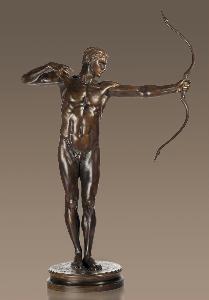Sir William Hamo Thornycroft
Sir William Hamo Thornycroft;Hamo Thornycroft
Place: London
Born: 1850
Death: 1925
Biography:
Early Life and Education
Sir William Hamo Thornycroft was born in London, England, on March 9, 1850, into a family of sculptors. His parents, Thomas and Mary, and his grandfather, John, were all distinguished sculptors. Thornycroft's early education took place at the Modern Free Grammar School in Macclesfield and later at the University College School in London. He then studied at the Royal Academy Schools, where he was influenced by the painter-sculptor Frederic Leighton.
Artistic Career
Thornycroft's artistic career began with assisting his father on the monumental sculptural group Boadicea and Her Daughters, installed beside Westminster Bridge in London. He won two medals and obtained his first paid commission for a work, a bust of Dr. Sharpey, while at the Royal Academy Schools. In 1871, Thornycroft visited Italy and Paris, where he developed his signature style of naturalism and simplicity. His works were exhibited regularly at the Royal Academy, showcasing his talent and skill. Notable Works Some of Thornycroft's notable works include:
- Teucer, a bronze sculpture depicting a nude male figure holding a bow and arrow, which can be found on Wikioo.org.
- Lot's Wife, an ideal genre statue created in 1878.
- Artemis and her Hound, a classical composition with increased naturalism, exhibited in 1880.
- The Mower, a life-size freestanding statue of a contemporary labourer, exhibited in 1884.
New Sculpture Movement
Thornycroft was a leading figure in the establishment of the New Sculpture movement, which provided a transition between the neoclassical styles of the 19th century and later modernist developments. His work, as seen on Wikioo.org, showcases his innovative approach to sculpture.
Legacy
Thornycroft's legacy can be seen in his numerous public monuments and portrait busts, including the statue of Oliver Cromwell outside the Palace of Westminster. His work is also featured on Wikipedia, providing further insight into his life and career. Thornycroft's contributions to the world of sculpture are undeniable, and his art continues to inspire and influence artists to this day.

